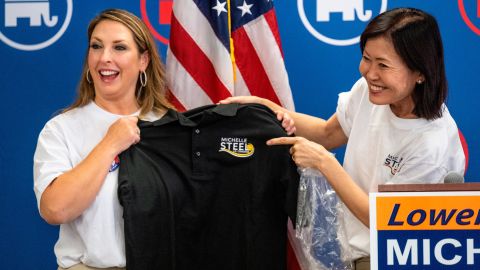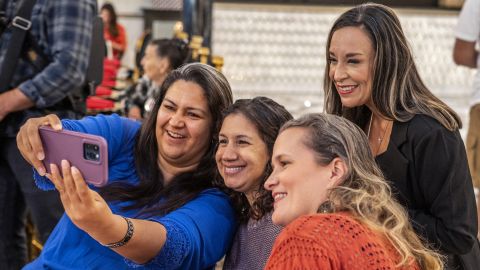“I’d really love to be here someday,” the Oregon Republican recalled telling her mother, who encouraged her to think about a run. She’d recently been elected to her city council, but she had her doubts. “I said, ‘Everybody on the floor there probably has a law degree. I’m a stay-at-home mom.’”
But Chavez-DeRemer flipped a Democratic seat in November, helping Republicans win a narrow House majority. She is now among a record 42 Republican women in Congress and one of the first two Latino members of Congress from Oregon.
The trail she has blazed is emblematic of the progress that the Republican Party has made in electing women over the past decade – hard-fought milestones reached only after outside groups began playing a larger role in primaries.
Still, GOP women are far from reaching parity with Democrats. Thirty-three of them will serve in the House alone this term, compared with 91 Democratic women. Though many women (and men who care about electing them) applaud a recent shift in attitude among GOP leadership and a segment of the donor class – for whom identity politics has often been anathema – long-term hurdles remain.
Some leaders, including House GOP Conference Chair Elise Stefanik and Republican National Committee Chair Ronna McDaniel, want to see the party do more.
That push is not just about statistics. It’s imperative as the party tries to appeal to a broader spectrum of voters, including the many suburban women who abandoned the GOP after Donald Trump was elected in 2016.
“Suburban women and independent women are going to continue to be the X factor in whether we win,” said Annie Dickerson, the founder and chair of Winning for Women, an outside group that helps elect female Republicans.
Trying to solve the primary problem
When Erin Houchin first ran for the Indiana state Senate in 2014, she urged a few party leaders to support female candidates in primaries – especially in deep-red seats where the primary is the only competitive election.
“The answer I got was, ‘Well, we don’t get involved in primaries. You should go see if other women will help you,’” Houchin recalled.
After winning her race, she ran for Congress in 2016 – the only woman in a five-person primary for a safe Republican seat. The party officially stayed out; the National Republican Congressional Committee’s policy is to never take sides in primaries.
Houchin had support from Republican women, including early backing from Value in Electing Women, or VIEW, PAC, which encouraged female members of Congress to write checks for her.
Those checks, however, were no match for what Houchin was up against: an opponent who benefited from a big-spending super PAC that likely could have outspent her even if she had more institutional party support. Trey Hollingsworth won that primary and the general election and went on to represent the 9th District for three terms before retiring last year.
Houchin was once again the only woman in the primary to succeed Hollingsworth out of a field of nine, but this time, she emerged the winner. She easily won the general election for a district that Trump would have carried by 27 points in 2020.

“There were many more groups this time around that did engage,” Houchin said, praising VIEW PAC, Winning for Women and Stefanik’s leadership PAC, known as Elevate PAC or E-PAC. “That made a difference.”
Republicans have long viewed supporting diverse candidates differently from Democrats, who were earlier to embrace building coalitions among specific demographics.
“Some of the Republican men didn’t necessarily think that it ought to be a priority,” GOP strategist Parker Poling, the executive director of the NRCC for the 2020 cycle, said of the party’s prior attitude toward boosting female candidates.
“I had to sell it very differently in the beginning, back in 2017,” Dickerson recalled. “And it was real work persuading donors that it wasn’t identity politics. It was really about identifying excellence.”
Stefanik raised the alarm with House GOP leaders after the 2018 election, when, as the first female recruitment chair of the NRCC, she had enlisted more than 100 women to run. Just one of them won.
Democrats flipped the House that year, buoyed in large part by the success of female candidates, but the number of GOP women in the chamber declined by nearly half. Even if Republican leaders didn’t immediately recognize the problem – then-NRCC Chairman Tom Emmer called Stefanik’s desire to get involved in primaries a “mistake” – they quickly came around in their public support for her mission.
“I am very proud that our efforts have been pretty much embraced across the board,” Stefanik said last month when asked if leadership now understands the importance of supporting women.
That commitment to changing those dynamics showed in 2020 – which some have called the “Year of the Republican Woman” – when a record-breaking number of nonincumbent House GOP female candidates won, helping flip several pivotal Democratic seats.
“There’s an understanding now that Republican women candidates can be very successful in the general election and in many cases are stronger candidates than men,” said Cam Savage, a veteran Republican consultant who worked for Houchin. “It’s been true for a while; it just hasn’t been recognized.”

McDaniel also noted that the tenor of conversations with donors has changed.
“Our investors – when I started, some of them would say to me candidly, ‘You have young kids. How can you be a mom and do this?’” she said. “I don’t have those conversations anymore. It’s more: ‘What other women candidates can we invest in?’ ‘Where can we support women in our party?’”
Winning in red districts
After impressive gains in 2020, Republican women made more nominal progress in 2022. Just one GOP woman, Virginia’s Jen Kiggans, unseated a Democratic incumbent in a swing seat, while several others flipped open seats in Oregon, Florida and Texas.
There’s excitement, however, about conservative women’s success in red districts and how that could help deepen and extend the longevity of the bench of female Republicans in Congress.
“You can’t just focus on electing women Republicans in swing seats. That’s why we had, you know, such a historic loss in 2018, as most of our women members were in those swing seats,” Stefanik said.
Of the seven nonincumbent Republican women elected last year, five represent districts Trump would have carried in 2020.
“That allows those members to gain seniority over time and also to make investments in other candidates,” added Stefanik.
In other words, electing women in safe seats means they’re more likely to stay there – although not always. Liz Cheney lost her deep-red Wyoming seat in a primary to another woman backed by Stefanik.
And those very primaries in deeply conservative districts have sometimes been harder for women to win, even if – based on their policy positions and voting records – they are the most conservative candidates.
Houchin, for example, said it was important for her to be very clear about where she stood on the issues because “it’s been easier to paint female candidates as more moderate or more liberal. That’s certainly not my profile.”
Helping women get through primaries in safe red seats could become more difficult after a deal reached between two outside groups as part of the Republican negotiations over the House speaker’s election. Congressional Leadership Fund, a super PAC backed by House Speaker Kevin McCarthy, agreed to stay out of open-seat primaries in exchange for the anti-tax Club for Growth’s support for his speakership bid.
The importance of empowering female candidates
Chavez-DeRemer — one of those Republican women to flip an open seat last year — now calls her self-doubts during that visit to the Capitol silly.

“Little did I know that, really, my whole life, I was probably preparing for this,” she said. “I needed to just be me.”
The former mayor of Happy Valley, in suburban Portland, won a five-way primary in Oregon’s 5th District and went on to win the general election over a Democratic woman, who had defeated the incumbent in her primary.
Her story speaks to the message pushed by potential White House aspirant Nikki Haley, who has channeled her energies into elevating female Republican candidates through her Stand for America PAC.
“What we need to do is to tell women, ‘We need you. We need you at the table. We need you making the decisions. We need your experience. We need your ability to talk about families and budgets and crime, and all of those things,” the former South Carolina governor and onetime US ambassador to the United Nations said in a brief interview on the campaign trail in Nevada last year.

“Success begets success,” Poling added of female candidates’ track record. “When people see that this helped us win more seats, then they’re more likely to put the time and effort into recruiting and helping female candidates.”
Party operatives credit strong recruitment – both in 2022 under NRCC recruitment chair Carol Miller of West Virginia and in 2020, under then-Rep. Susan Brooks of Indiana.
“That begins with the acknowledgment that the way you recruit women is different from men,” Savage said. “You don’t have to recruit men. They line up to tell you they’re the best fit.”
But one of the major lessons from 2018 is the recognition that getting women to run isn’t enough: Helping them through the process is also critical.
“I don’t look at women as a monolith – they come with different backgrounds and experience – but sometimes fundraising can be a challenge, or life balance,” said McDaniel, who was elected RNC chair in 2017.
One part of addressing that is female candidates supporting each other. Monica De La Cruz was one of three Republican women running for South Texas swing districts along the southern border last year.
“We had a support group of women who understood exactly what you were going through at that moment, so it was a very special time,” said De La Cruz, the only one of the three to win.
And increasingly, there’s recognition that a female perspective can be a strength in the eyes of voters.
“I had no political background. I’m a small-business owner, single mom of two teenage children. And people could relate to that,” said De La Cruz, who has been tapped to serve on the RNC’s advisory panel to examine how the party can continue broadening its appeal to women and more diverse voters.

“They saw me at the Friday night football games, and the Saturday morning volleyball games,” she said. “They saw me in parent-teacher conferences at the school. My community saw themselves in me.”
Obstacles remain
The GOP still has a lot of catching up to do. Even with leadership PACs and outside groups committed to boosting women in Republican primaries, the party lacks the firepower of a group like EMILY’s List, which has been helping elect Democratic women who support abortion rights since the mid-1980s.
Some of the outside groups backing GOP women have diverged in primaries, either not engaging in the same races or even backing different women in the same primaries.
To expand institutional support, McDaniel pointed to the example of programs such as League of Our Own, a campaign program she worked with in her home state of Michigan that has focused on training female candidates.
“We talked about things like, ‘How do you raise money? How do you pick a campaign manager?’” McDaniel said. “You’d see these women who were graduates, going on to be state reps or state senators. It’s really, really impactful to see how even just that little bit of campaign school and that little bit of help can go a long way in bringing women into the conversation.”
Chavez-DeRemer said the party must “keep reaching out” and “make sure that all women are running at a local level.”
Stefanik echoed that sentiment, pointing to a robust state and local pipeline as a lynchpin to deepening the bench of Republican women in Congress in the years ahead.
“It’s a long-term strategy,” she said.
